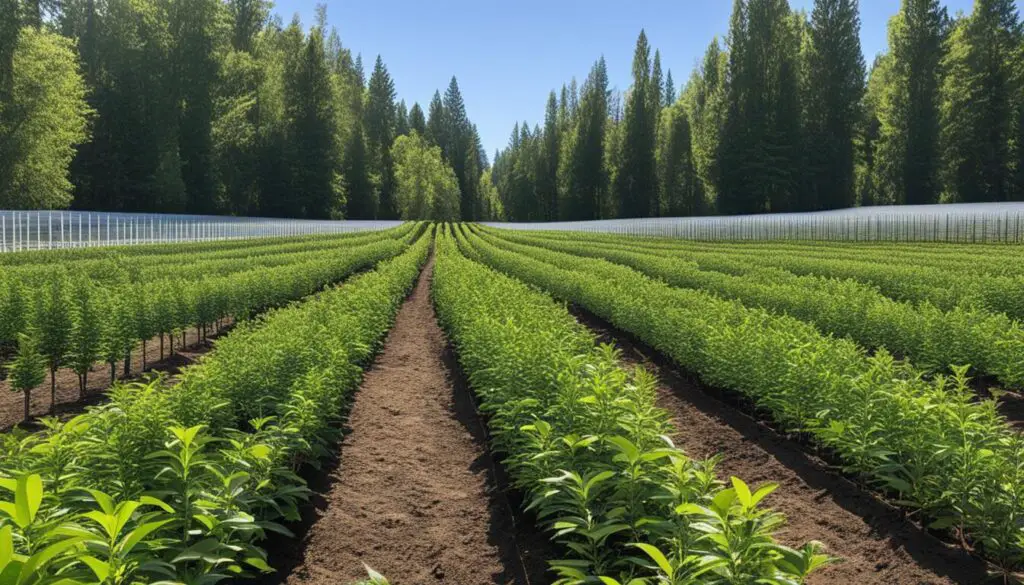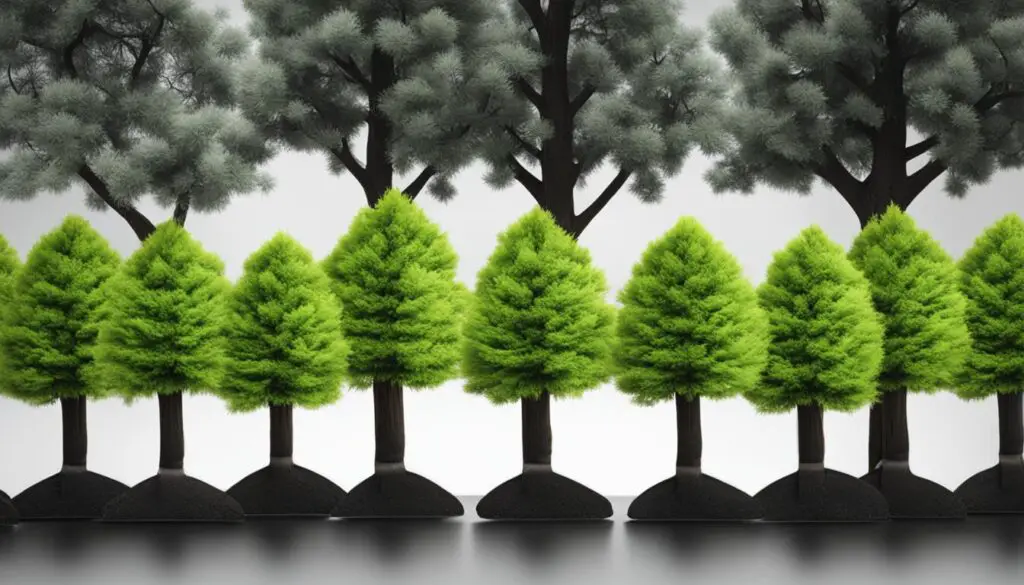When it comes to purchasing trees, the cost can sometimes be a bit of a mystery. How much should you expect to pay? What factors affect the price? In this article, we will delve into the world of tree pricing and provide you with a comprehensive guide to help you understand the average cost of trees and make informed decisions about your purchase.
Key Takeaways:
- The cost of a tree can vary widely depending on factors such as size, species, and location.
- On average, a 6 to 8-foot tree can range from $100 to $200, while larger trees can cost several thousand dollars.
- Consider purchasing trees from nurseries or through landscaping services, comparing prices from different sources.
- Budget for tree installation and long-term maintenance costs when planning your purchase.
- Don’t forget to weigh the environmental benefits of trees when considering their value.
Factors Affecting Tree Pricing
When it comes to determining the price of a tree, several key factors come into play. By understanding these factors, you can better navigate the tree-buying process and make informed decisions. Here are some of the factors that can affect the pricing of trees:
- Size: The size of the tree is an important consideration. Generally, larger trees will cost more than smaller ones. This is because larger trees require more time, effort, and resources to grow and transport.
- Species: The species of the tree can also impact its price. Some rare or exotic tree species may be more expensive due to their scarcity or unique characteristics.
- Location: The location where the tree will be planted can influence its cost. Trees in urban areas or areas with limited accessibility may require additional labor and equipment for planting, which can increase the overall price.
These are just a few of the factors that can affect tree pricing. It’s important to keep them in mind when comparing prices and making decisions about which trees to purchase. By considering these factors, you can ensure that you get the right tree at the right price for your specific needs.
Importance of Comparing Tree Prices
Comparing tree prices is essential to getting the best deal for your money. Prices can vary significantly between different suppliers, so taking the time to research and compare can save you a substantial amount. Remember to consider factors such as size, species, and location when comparing prices, as these can all impact the overall cost.
By comparing prices, you can ensure that you are getting a fair deal and not overpaying for your trees. It’s worth reaching out to multiple nurseries, landscapers, and online retailers to obtain quotes and compare offerings. Don’t forget to factor in the quality of the trees and any additional services provided when making your decision.
Ultimately, comparing tree prices allows you to make an informed choice and find the best tree at the best price. It’s a valuable step in the tree-buying process that can help you save money while still getting high-quality trees for your landscaping needs.
Buying Trees From a Nursery
One common way to purchase trees is through a nursery. Nurseries offer a wide variety of tree species, sizes, and prices. The cost of trees at a nursery can vary depending on the specific species and size. It’s important to do some research and visit different nurseries to compare prices and quality. Additionally, nurseries may offer discounts or deals during certain times of the year, so it’s worth checking for any promotions or sales to get the best price.

“Nurseries offer a wide variety of tree species, sizes, and prices.”
When buying trees from a nursery, you have the advantage of being able to see the trees in person and get expert advice. This can be especially helpful if you’re new to gardening and need guidance on selecting the right tree for your specific needs. Additionally, nurseries often have a wider range of tree options compared to other sources, allowing you to choose from a greater selection. By visiting nurseries and comparing prices, you can find affordable tree prices and ensure you’re getting the best value for your money.
Benefits of Buying Trees From a Nursery:
- Wide variety of tree species, sizes, and prices
- Expert advice and guidance
- Opportunity to see the trees in person
- Possible discounts and promotions
Hiring a Landscaping Service
When it comes to purchasing trees, hiring a professional landscaping service can offer a convenient option. Not only can landscapers assist with tree selection, but they can also handle the planting and maintenance process. Before hiring a landscaping service, it’s essential to understand the potential costs involved.
When working with a landscaping service, it’s important to get a detailed cost estimate in advance. The cost of the tree itself will likely be included in the estimate, but additional fees for labor, equipment, and other services may apply. By obtaining a comprehensive cost estimate, you can budget accordingly and avoid any surprises.
It’s worth noting that the cost of hiring a landscaping service can vary depending on the specific project and location. Factors such as the size of the tree, the accessibility of the planting site, and any additional services required can all impact the overall cost. Therefore, it’s important to communicate your needs clearly with the landscaping service to ensure an accurate cost estimate.
By working with a professional landscaping service, you can take advantage of their expertise and ensure that your tree is planted and maintained properly. The cost of hiring a landscaping service may be higher compared to purchasing a tree from a nursery, but the added convenience and expertise can make it a worthwhile investment.
Tree Price Guide
When it comes to the cost of trees, prices can vary depending on various factors such as size, species, and location. To help you get an idea of the price range for different tree species, here is a general price guide based on industry averages:
Oak Trees
Price range: $200 – $500
Maple Trees
Price range: $150 – $400
Palm Trees
Price range: $100 – $1,000
Spruce Trees
Price range: $100 – $300
Flowering Trees
Price range: $50 – $500
Keep in mind that these are just average price ranges and actual prices may vary depending on the specific tree and where you purchase it. It’s always a good idea to research and compare prices from different sources to find the best deal.
Cost of Tree Installation
In addition to the cost of the tree itself, you may need to budget for the installation or planting of the tree. The cost of tree installation can vary depending on several factors. The size of the tree is one such factor, as larger trees may require more labor and equipment to plant properly. The accessibility of the planting site is another consideration, as trees in hard-to-reach areas may require additional effort to transport and install.
Some landscaping services may include tree planting in their overall price, while others may charge an additional fee for this service. It’s important to get a clear understanding of the installation costs before making a purchase. Requesting a cost estimate from the landscaping service will help you budget accordingly and avoid any unexpected expenses.

Factors to Consider:
- The size of the tree
- The accessibility of the planting site
- Additional services required (e.g. soil preparation, staking)
- The specific requirements of the tree species
By considering these factors and getting a clear understanding of the installation costs, you can budget effectively and make an informed decision when purchasing a tree.
Maintenance and Care Costs
When purchasing a tree, it’s important to consider not only the upfront cost but also the long-term expenses associated with maintaining and caring for the tree. While the initial purchase price may be a one-time expense, ongoing maintenance costs can add up over time. These costs include regular pruning, fertilizing, and pest control to keep the tree healthy and thriving.
According to industry estimates, the average annual maintenance cost for a medium-sized tree ranges from $150 to $300. However, these costs can vary depending on factors such as the size and species of the tree, as well as the local climate and environmental conditions.
Additionally, it’s important to consider any specialized care that certain tree species may require. For example, some trees may need regular professional pruning or specialized treatments to prevent diseases or pests. These additional care requirements can increase the overall maintenance costs.
The Benefits of Regular Maintenance
While maintenance costs may seem like an added expense, investing in the care of your tree can yield significant benefits. Regular maintenance helps ensure the health and longevity of the tree, reducing the risk of disease, pest infestations, and structural problems. Well-maintained trees are more likely to thrive and provide the desired aesthetic appeal, shade, and environmental benefits.
Regular tree maintenance not only enhances the beauty of your landscape but also adds value to your property. A well-cared-for tree can increase property value by up to 14%, according to the International Society of Arboriculture.
By budgeting for ongoing tree maintenance and care, you can enjoy the many benefits that trees provide while minimizing the risk of costly repairs or removal in the future.
The Environmental Benefits of Trees
While it’s important to consider the cost of trees, it’s equally crucial to recognize the significant environmental benefits they provide. Trees play a vital role in enhancing our surroundings and improving our quality of life. They act as natural air filters, absorbing harmful pollutants and releasing clean oxygen into the atmosphere. This helps to improve air quality and contributes to the overall well-being of both humans and wildlife.
Trees also have the ability to reduce noise pollution by acting as sound barriers. The leaves, branches, and trunks of trees absorb and deflect sound waves, minimizing noise disturbances from nearby traffic or other sources. This can create a more peaceful and tranquil environment.
Another valuable benefit of trees is their ability to provide shade, which helps to lower temperatures in urban areas and reduce the need for air conditioning. By strategically planting trees to shade buildings and outdoor spaces, we can create cooler microclimates and conserve energy. Furthermore, trees act as natural insulation, reducing heat loss in colder climates and lowering heating costs.
By recognizing the environmental benefits of trees, we can appreciate the value they bring beyond their cost. Trees are not only aesthetically pleasing and beneficial to our health and well-being, but they also play a crucial role in combating climate change and creating sustainable communities.

Key Environmental Benefits of Trees:
- Improving air quality by absorbing pollutants and releasing oxygen
- Reducing noise pollution by acting as sound barriers
- Providing shade to lower temperatures and reduce energy consumption
- Serving as natural insulation to lower heating costs
- Supporting biodiversity and providing habitat for wildlife
- Contributing to the overall aesthetics and well-being of communities
Where to Buy Trees
When it comes to buying trees, there are several options available to you. Each option has its own advantages and disadvantages, so it’s important to consider factors such as price, quality, and convenience before making a decision.
One option is to visit local nurseries and garden centers. This allows you to see the trees in person and get expert advice from knowledgeable staff. Nurseries and garden centers often have a wide selection of trees to choose from, and you can compare prices and quality before making a purchase.
Another option is to explore online retailers. Online retailers offer a convenient way to browse and purchase trees from the comfort of your own home. They often have a larger selection than local nurseries and garden centers, and you can often find lower prices. However, it’s important to read reviews and ensure that the retailer is reputable before making a purchase.
“I found that visiting local nurseries allowed me to see the trees up close and get personalized advice. However, I also found great deals online and was able to find a wider variety of trees that weren’t available locally.” – Tree Enthusiast
If you prefer a more hands-off approach, hiring a local landscaping service is another option. Landscapers can help with tree selection, planting, and maintenance, providing a comprehensive service. They can often source high-quality trees for you and take care of all the necessary arrangements.
Ultimately, the choice of where to buy trees depends on your specific preferences and needs. Whether you decide to visit local nurseries, shop online, or work with a landscaping service, the key is to do your research, compare prices, and ensure that you are getting the best tree at an affordable price.

Tree Cost Comparison
When it comes to purchasing trees, it’s important to compare prices from different sources to ensure you’re getting the best deal. By taking the time to research and obtain quotes from multiple nurseries, landscapers, and online retailers, you can make an informed decision and find the tree that fits your budget and requirements.
Factors to Consider:
- Quality of the trees: Ensure that you are getting healthy and well-maintained trees that are worth the price.
- Additional services provided: Some sellers may offer services like planting or delivery, which can add value to your purchase.
- Warranties or guarantees: Check if there are any warranties or guarantees offered, as this can provide peace of mind.
By comparing prices and considering these factors, you can find the best tree at the best price.
Quote:
“Comparing prices and options is key to finding the right tree at the right price.” – Tree Expert
Tree Buying Guide Recap:
Throughout this guide, we’ve explored the various factors that can affect the cost of trees, including size, species, location, and source. We’ve discussed the options of buying from a nursery or hiring a landscaping service, as well as the importance of considering the long-term maintenance and care costs. Additionally, we’ve highlighted the environmental benefits of trees and the value they can bring to your property. By carefully considering these factors and comparing prices, you can make a well-informed decision and find the perfect tree at a price that fits your budget.
Budgeting for Tree Purchase
When it comes to purchasing a tree, it’s essential to consider your budget and plan accordingly. By understanding the costs involved, you can ensure that you find an affordable tree that meets your needs. Here are some key factors to keep in mind when budgeting for a tree purchase:
- Price of the Tree: The cost of the tree itself will vary depending on its size, species, and where it is purchased. Consider the average prices for different types of trees and determine how much you are willing to spend.
- Installation Costs: If you plan on hiring a professional landscaping service for tree installation, factor in the associated costs. These may include labor fees, equipment rental, and any additional services required.
- Maintenance and Care: Remember that owning a tree comes with ongoing maintenance costs, such as pruning, fertilizing, and pest control. Take these expenses into account when setting your budget.
By having a clear understanding of the costs involved, you can make an informed decision and find an affordable tree that aligns with your financial capabilities. Remember to consider the long-term benefits and value the tree will provide to your property and the environment.
Quote:
“Budgeting for a tree purchase is crucial in finding an affordable yet quality tree. Consider not only the initial price but also the installation and maintenance costs. By planning ahead, you can find the perfect tree that fits within your budget.”
Whether you’re looking for an ornamental tree for your garden or a shade tree for your backyard, budgeting is key. Take the time to research prices and compare options from different sources such as nurseries, garden centers, and online retailers. Keep an eye out for any promotions or discounts that may help you save on your tree purchase. With careful planning and budgeting, you can find an affordable tree that will enhance the beauty and value of your outdoor space.
Conclusion
In conclusion, when considering the average cost of trees, there are several factors that can influence the price. Size, species, location, and source all play a role in determining the cost of a tree. To find the best deal, it is crucial to research and compare prices from different nurseries, online retailers, and landscaping services.
When buying a tree, it is also important to budget for additional expenses such as installation and ongoing maintenance. These costs can vary depending on the size of the tree, the accessibility of the planting site, and the specific services required. By factoring in these long-term costs, you can make a more informed decision and avoid any surprises down the line.
While considering the price, don’t forget about the environmental benefits that trees provide. They improve air quality, reduce noise pollution, and offer shade and habitat for wildlife. Trees can also help save energy by providing natural cooling and insulation. By weighing the cost against these benefits, you can truly understand the value that trees can bring to your property and the environment.
So, when it comes to purchasing a tree, take the time to evaluate your options and make an informed decision. Consider the pricing factors, follow the tree buying guide, and be mindful of the average cost of trees. By doing so, you can find the perfect tree that meets your needs, at a price that fits your budget.
FAQ
How much do trees typically cost?
The cost of a tree can vary depending on factors such as size, species, location, and source. On average, a 6 to 8-foot tree can cost around $100 to $200, while larger trees can range from $500 to several thousand dollars.
What factors affect the pricing of trees?
The size, species, and location of a tree can impact its cost. Larger trees generally cost more than smaller ones, and rare or exotic species may command higher prices. Trees in urban areas or areas with limited accessibility may require additional labor, affecting the cost.
Where can I buy trees?
Trees can be purchased from nurseries, garden centers, online retailers, and local landscaping services. Each option has its advantages and disadvantages, so consider factors such as price, quality, and convenience when deciding where to buy.
How can I find the best deal on a tree?
To find the best deal, research and compare prices from different sources. Obtain quotes from multiple nurseries, landscapers, and online retailers. Consider factors such as tree quality, additional services provided, and any warranties or guarantees offered.
What costs should I consider when budgeting for a tree purchase?
When budgeting for a tree purchase, consider the cost of the tree itself, installation or planting fees, and ongoing maintenance expenses. Pruning, fertilizing, and pest control can add to the long-term costs of owning a tree.
What are the environmental benefits of trees?
Trees provide multiple environmental benefits, including improving air quality, reducing noise pollution, providing shade and habitat for wildlife, and helping to reduce energy costs by providing natural cooling and insulation.

